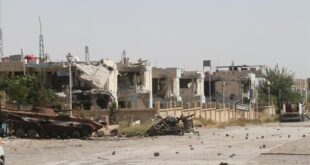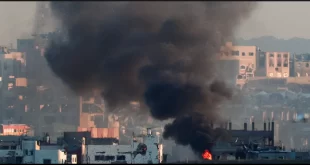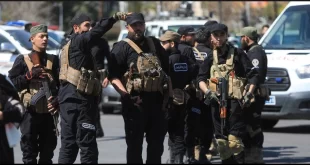Jul 2015, Crescent International
This report is from an Aleppo resident whose identity is protected for the sake of his entire family’s safety and security. They are living through the daily hardships of life in an externally created war zone. Water and electricity shortages, NATO- and US-backed terrorists embedded in multiple areas of the city creating random buffer zones where the risk of being sniped or shelled is a daily occurrence.
Aleppo, Crescent-online
Monday July 27, 2015, 13:19 DST
(Editing has been kept to a minimum in order to retain as much as possible of the original report as it is important to maintain the narrative as is—raw and heartfelt—from someone who sees this ravaged city as home.)
Travelling to the other part of the city
A friendly taxi driver we know wanted to visit his house on the other side of Aleppo. This is an area where the terrorists and the so-called “rebels” are in control.
He had heard that Syrian jets attacked the area and bombed a place close to his house. He went in the Eid vacation (17-19th of July) with his wife for two days.
A trip that used to take 20-30 min from one part of the city to another, took something like 10 hours, because they had to go 25 miles away from the city to make a U-turn and enter from another area. They had to pass through many villages under terrorist control to reach the eastern part of Aleppo city, and finally their home.
They went in a bus, and he didn’t take his taxi car as terrorists might take it from him by force.
He told me that the trip cost them $70-$100 over two days (transport, eating …etc); he was complaining because it’s a lot of money for him, equivalent to minimum one week’s full time work.
They (the terrorists) took most of their clothes that were still there. Thanks to their two neighbours who are still living in the building who protected their apartment. The remaining apartments and houses in the quarter had been robbed, broken into or damaged because they had been converted into nesting places for the terrorists.
Many good people are still going from one part of the city to the other. Many people didn’t deserve to be kicked out from their homes, and it wasn’t their choice to stay in one place or become refugees in another place.
Visiting each side is still possible for people, but it’s dangerous and not a risk I would want to take.
Citadel
My understanding is that on the 13th/14th of July, the Syrian army – who are occupying the very strategic acropolis hill of the ancient citadel of Aleppo, in the middle of the ancient walled city, which is under terrorist control – knew about a new tunnel that the terrorists were digging and filling up with explosives, very close to the citadel’s borders.
The Army made a counter attack and forced the terrorists out of the tunnel in a hurry. Unfortunately the terrorists detonated these explosives before they left, and that explosion was enough to destroy part of the ramparts of the citadel.
I can’t help thinking if the Army hadn’t discovered this tunnel and if terrorists had drilled a longer and deeper tunnel, and packed it with 10 times more explosives, maybe the whole citadel would have collapsed.
Khosrawiyya/Chusruviyya mosque, the first and oldest Ottoman mosque in Aleppo [built in 1544] has been demolished. Same for Carlton Hotel that occupied a century old building as a multi million dollar investment.
The Mayor’s town hall, 12 stories high, has been 80% destroyed. A Memluk or Ayyoubid period small mosque and religious school [700-1000 years old] has disappeared apart from its gate and the little minaret above the gate.
The Traditional/Turkish Bath of Yalbogha al-Nasseri [700-800 years old] is still there, but some of its big domes have collapsed. Another century-old building – that I remember sitting in for 3-4 hours 15 years ago, manually copying some information to use in my graduation project – has been damaged so badly, especially its beautiful double mirrored spiral staircase at the entrance, that it has virtually disappeared without a trace.
Those buildings have all been destroyed by the same terrorist techniques, within the last 4 years of war in the city: digging tunnels, or using ancient existing networks of tunnels under the whole old city of Aleppo.
Filling them up with explosives, to bomb everything above them. While these explosions serve as a distraction, terrorist troops will attack another target, mostly the citadel where the Syrian army is encamped. They failed so far to take control of the SAA stronghold, but damage to the citadel is extensive.
Although what I mentioned above is horrible, and I know about other famous areas [markets, bazaars, mosques and churches] that have been sabotaged or destroyed, I was pleased that way more areas and buildings of the old city are still there, as I know them. Maybe they are not that famous or masterpieces, but they are still there untouched and intact.
The war targeted the symbols of Aleppo [the same strategy in all Syria, of course]. The bazaar of Aleppo, which has been there since 4th century CE, since the Hellenic era, is a symbol, and it has been completely torched. A week of continuous burning, with the smoke permeating throughout the city and this piece of history is reduced to ashes on the ground.
The Great Umayyad Mosque is a symbol; it is almost 1000-year-old minaret has been destroyed by dynamite. The minbar (platform to deliver the sermon) has been dismantled (most of it taken to Turkey).
Several sidewalls have been completely destroyed. They turned the mosque into its original and oldest land use: an Agora [Plaza] in the Hellenic era. A similar fate for all the other lost places and monuments.
The last symbol left of Aleppo is the most famous one: the Citadel. I can see part of it from our balcony, but I can see it more clearly from the roof of the building.
It’s still there, resisting the terrorists and their funding states. It has been badly injured, but it’s still there dominating the city skyline. It’s where they found the Storm God’s Temple [2nd millennium BC] a few years ago.
It has withstood many invaders, including the Mongols and Crusaders. It has been damaged severely several times throughout history, but it has been rebuilt over and over again, as an immortal symbol to the inhabitants, of one of the oldest living cities in history.
I just pray I don’t live to witness its total destruction as I have seen happen to many of the surrounding buildings.
Socially
Aleppo city has shrunk to a fifth of its original size but has become overcrowded with refugees that fled their own areas after they fell into terrorist hands.
I walk everyday in the city. I see children, young girls without limbs because of terrorist mortars or shrapnel that target them randomly and cause terrible wounds and horrific memories that will never leave them.
The girl who lost one leg is standing on her good leg and selling bread, while the little boy who lost one arm is selling chewing gum. Those are the “injured” people who are mentioned fleetingly in the news, just numbers in one line of a report, after each attack from the terrorists.
“Injured” doesn’t mean scratched or having a bleeding finger; it means someone lost his eyes or her limbs.
At night during Ramadan, some areas were still playing live music while audiences smoke their sheesha and enjoy a cold drink. One can’t help but admire the spirit of these musicians, resisting all the harsh situation of the crisis.
Because of the war and lack of income, many females are selling themselves for money. Prostitution has become very common and “normal” in Aleppo, and it has affected all social classes and levels. It has always existed throughout history but it has never been seen on this scale and with so many permutations.
It is symbolic of the depths to which people are being forced to stoop to eke out a meager existence in circumstances that drain all resources and diminish all hope.
The daily talk of every youth is emigration and leaving the city. Everyone wants to leave for Europe, mostly to Sweden, which has accepted a huge number of Syrian refugees. The usual trip starts from Syria to Turkey, then they go in boats to Greece, and that is a very dangerous trip because many have lost their lives and have drowned.
Once they reach Greece, it is a laborious process before they end up either in Germany or Sweden. There is a new “market” for smuggling people to Europe in such illegal ways. Everyone believes the myth that once they reach Sweden, the government will give them free houses and 500 Euros per person.
I keep telling them that this amount of money might be a fortune in Syria, but it’s not over there, and life is not that cheap. However, they just want to leave. Life outside Syria seems like heaven to them and they want their children to be safe and to have a future.
What happened in Syria in general, and Aleppo in particular, can be described as a great “shock” which people are still unable to believe.
Sudden influx of money
Between 2006-2011, Turkey, Qatar, Saudi and almost all of Europe and the US established relations with Syria and funded many international investments in the country. History will eventually reveal if that act was a trap or a bribe or bad luck, to shower the people with unprecedented wealth, and take it all back within a few years, replacing that shower with mortars and shelling.
All of a sudden, malls started to spring up in big cities like mushrooms. Brand new cars and vehicles were commonplace to see in the streets, including Porsches, Lamborghini, and Ferraris.
In my neighbourhood and other areas, many new buildings replaced old ones. Many friends I know told me that they were paying $20,000 – $25,000 as salaries for workers in factories and contractor firms! Work was amazing, everyone was happy.
There is an architect who left Europe and came back to Syria to work on an architectural project for a Dutch firm in Damascus. All of Syria and its people were taken to the peak of wealth, and then it all collapsed as if an earthquake had destroyed everything in its path. Unbelievable tragedy.
My brother saw his once rich and wealthy friend selling small items [plastics, gum… etc] on the street in front of a mosque, and he didn’t believe it. The friend told him that he had lost everything, and he has a family to feed and needs to put food on the table. Turkey dismantled and stole his factory.
His land has been burned, his properties have been either damaged or stolen, and he was bankrupted in no time at all.
Each day there is a new story, real tragedies that reach my ears and heart. All of a sudden, everything ends and people’s world collapses around them.
One $8 million factory was dismantled and stolen by Turkey. The owner had a stroke and died because of such losses. Aleppo’s industry has been torn apart and stolen by Turkey.
Workers who were paid by an architect or an investor became leaders of a “rebel” battalion. They can now rape as many ladies as they want; they have millions of US dollars, and return with their militias to destroy the work of this architect or that investor, out of God knows what… rage? Revenge? It is impossible to understand what motivates them to commit such crimes against their own people.
Another person who I met, told me that he had been kidnapped and such a huge ransom was demanded that he was immediately became bankrupt after paying it. He lost his factories and all of his trade and now he is suffering from diabetes and blood pressure and heart problems.
You’ll see it in each person’s eyes: a glimmer of light and a sad smile, while remembering how they were so rich and wealthy, travelling to Europe three times a year for pleasure and tourism, having the best life ever over here in Syria, and having great dreams for their children and potential promises for building the country and modernizing their cities…. Then, all of a sudden, everything disappeared.
One old friend told me that his youngest two girls, who are 4 and 6 years old, didn’t know what sea and mountains looked like until a couple of months ago when he managed to take his family for a trip to the coast and mountains. They hadn’t been able to leave their home for 4-5 years.
A neighbour’s girl came back to her parents with her three teenage girls after the terrorists occupied her house in another “infected” area of the city. They looted whatever they could, and didn’t leave before plundering and sacking the whole house.
Sabotaging can entail burning or breaking furniture, but when someone sees all his rooms and furniture and family pictures stained with human faeces, that is disgusting and humiliating.
I actually heard such stories when I was still outside Syria, but I thought these were isolated acts, not a common strategy in that sector of the city, to humiliate people and force them to leave home.
So, their daughter sold her apartment and didn’t want to see it again, and went back to her parents. Others became refugees. Others sold their daughters to the prostitution market… stories after stories that break my heart, and make me wonder how this could possibly come to pass and who planned it?
(Courtesy: https://thewallwillfall.wordpress.com/2015/07/25/update-from-aleppo/ – respond)
 Syria Support Movement solidarity with the Syrian people
Syria Support Movement solidarity with the Syrian people




